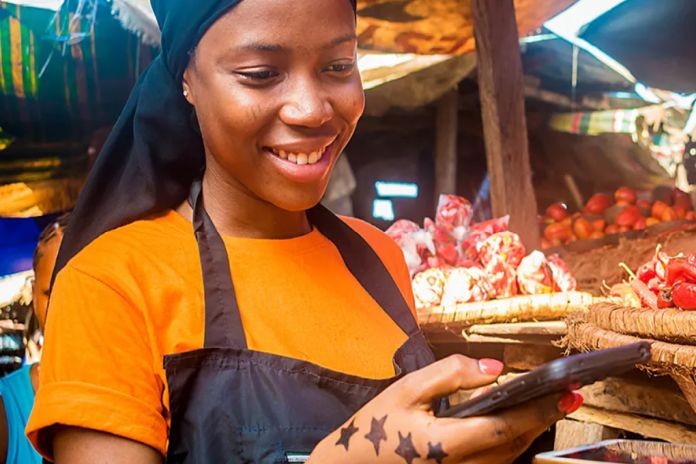By Marie-Hélène Ferrer, Caroline Perrin and Luc Jacolin
Although it is a factor in financial inclusion and development, the growth of mobile banking in Sub-Saharan Africa (SSA) has nonetheless gone hand in hand with a growing gender gap in financial inclusion. This growing gap reflects the persistent digital divide between men and women that is also observed among financial institutions.
A scissor effect connected with the spread of mobile banking?
Financial inclusion of both women and men has increased significantly in SSA over the past decade. According to the World Bank, bank coverage has reached the majority of people in SSA (55 percent of the population in 2021, compared to 23 percent in 2011; see figure 1), with relative catch-up effects compared to middle- and high-income countries (72 and 96 percent of the population, respectively). An even greater increase was observed in the WAEMU and the CEMAC, where bank penetration rates increased nearly fourfold.
This was made possible by the rapid development of mobile telephony and mobile banking, which compensate for the weaknesses of fixed-line telephony infrastructures and the traditional banking sector. Mobile bank accounts (or mobile money), which by 2021 would cover one-third of the population of SSA, constitute a growing channel for access to credit, reaching 7 percent of the population, compared to 14 percent for the formal financial sector (and 56 percent including informal finance).
However, the increase in bank enrollment has not been as rapid for women as for men in SSA. While the gender gap has narrowed significantly in high- and middle-income countries, in SSA, it has increased by 7 percentage points since 2011, to 12 percent in 2021 (figure 2). In terms of access to credit, the gender gap in SSA increased from 1 to 3 percent between 2011 and 2021, to a level similar to that of middle- and high-income countries (4 and 2 percent, respectively). While women are overrepresented in the portfolios of microfinance institutions (80 percent of clients globally and 64 percent in SSA), these institutions do not fully substitute for formal credit, as they target the most disadvantaged populations, with different lending conditions (small amounts, short maturities, and high interest rates).
The growth of the gender gap in SSA could be linked to the spread of financial digitalization.
It might be expected that the technological innovations used by mobile banking would contribute to women’s empowerment, thanks to their ease of use, accessibility, and the time and mobility savings they provide. However, women’s low level of access to equipment tends to marginalize them: the gender gap in internet access increased from 21 percent in 2013 to 33 percent in 2019 due to cultural or socioeconomic barriers (lower income, lower access to education, and lower access to formal employment). This resulted in a doubling of the mobile banking access gap, from 3 to 6 percent between 2014 and 2021, suggesting that the beneficial effects of these innovations have been gender asymmetric in SSA.
The financial divide at the expense of women is a sustainable development issue
These gaps contribute to continued financial constraints on private sector development and limit growth potential in SSA. In addition to better “countercyclical” smoothing of household consumption, financial inclusion contributes to better performance of enterprises, better sectoral allocation of capital, and lower cost of remittances from migrants. On the banking side, better access to credit for women contributes to financial stability as the quality of bank credit portfolios improves when women’s share of credit increases, particularly in low-income countries.
Women’s access to financial services is a driver of social cohesion and sustainable development .
Greater financial inclusion of women also contributes to improved household well-being and economic resilience. As Duflo (2012) shows, women tend to invest in less risky and more socially beneficial activities, such as social protection and childrearing. Gender equality in financial inclusion is thus a lever that facilitates the achievement of eight of the 17 Sustainable Development Goals proposed by the United Nations.
What levers can be used to reduce the dual financial and digital divide?
Cross-cutting policies to fight poverty and promote human development help to address the inequalities that account for a large part of the gender gap in access to both digital tools and financial services. In SSA, the promotion of financial inclusion requires reducing numerous barriers to entry, independent of gender, such as the reduction of the cost of formal financial services and the persistence of significant information asymmetries.
Establishing an appropriate legal framework is a critical entry point for overcoming women’s lack of financial inclusion. Depending on the country, this may involve removing laws that prevent women from opening a bank account without their husband’s consent (still the case in six SSA countries in 2021), or establishing and enforcing laws to eliminate discrimination in access to banking services.
Recent international recommendations highlight the need to promote digital financial inclusion for women as part of national or regional strategies. G7 Partnership for Women’s Digital Financial inclusion in Africa for example, has resulted in four multilateral initiatives covering a broad thematic area with a priority in Africa: digital identification, interoperability of payment systems , regulation, gender-based research on the impact on the impact of digital identification and payments in Africa.
Women’s digital financial inclusion raises significant issues for the financial sector. The first is the adoption of statistical monitoring, with procedures and practices that encourage women’s access to and use of financial services. The second is the possibility, still not widespread in SSA, of adapting financial services to women’s constraints and financial needs, for example, through guarantee mechanisms that encourage female entrepreneurship.
The last concerns microfinance institutions, which are the historical vector of women’s financial inclusion. Digitization entails excessively high costs in relation to the small size of firms. Thus, achieving financial inclusion requires reconciling the automation of procedures with the human solidarity that underpins their effectiveness.
![]()





